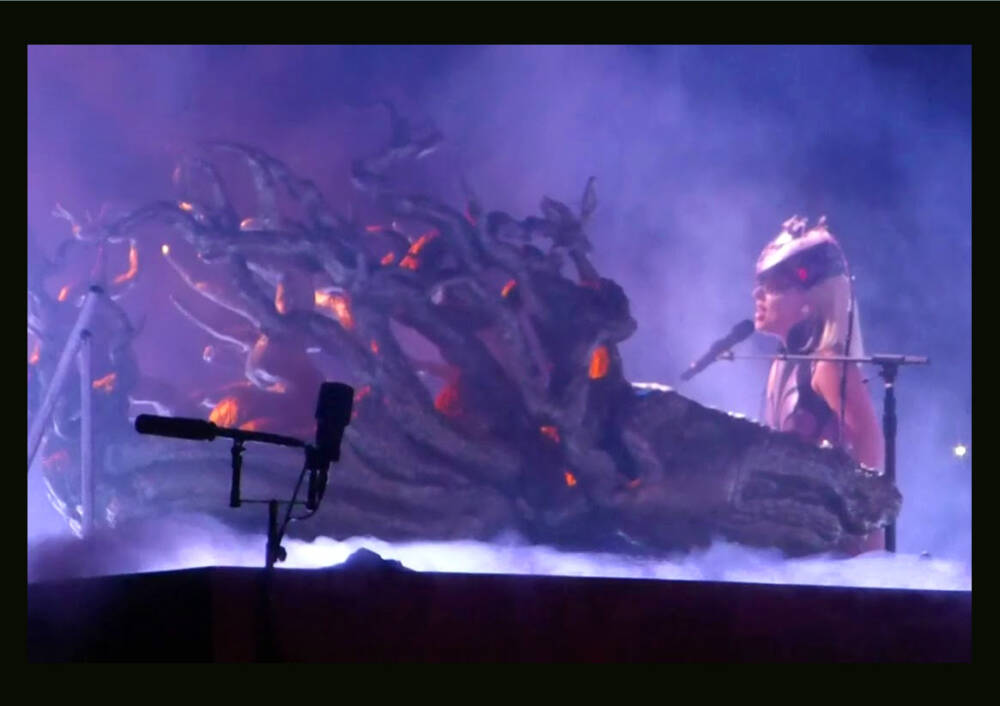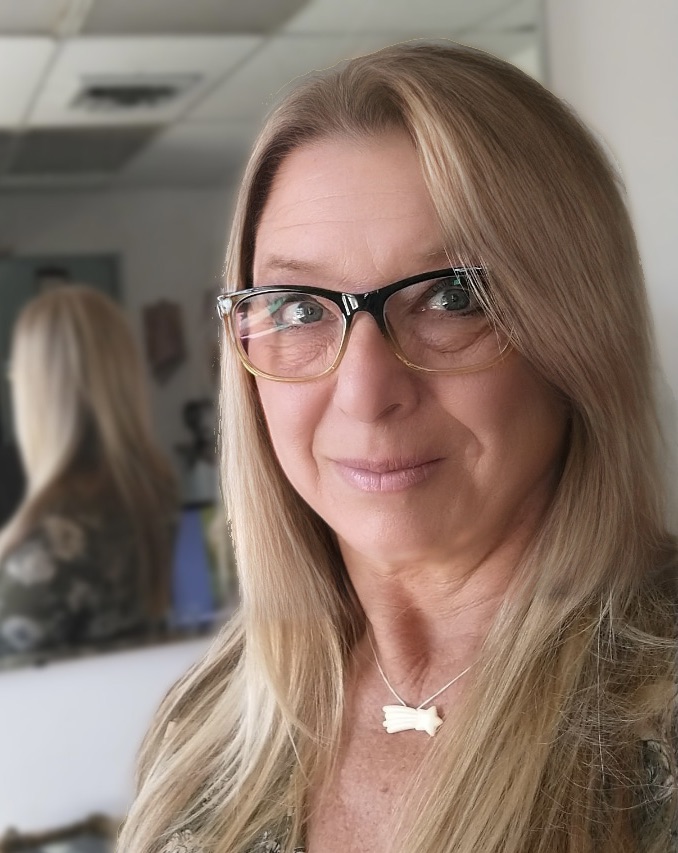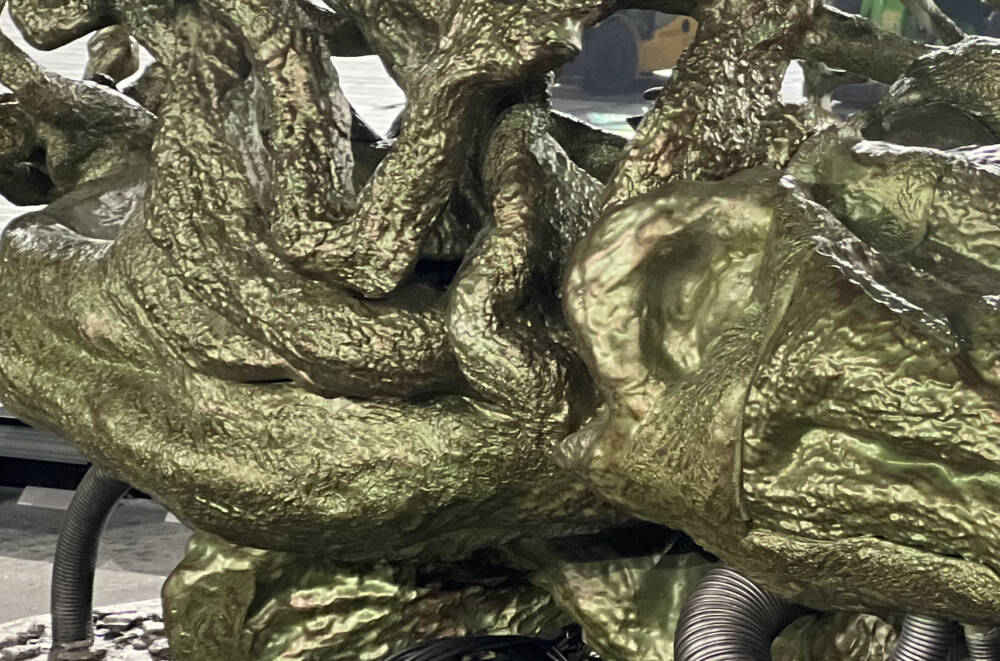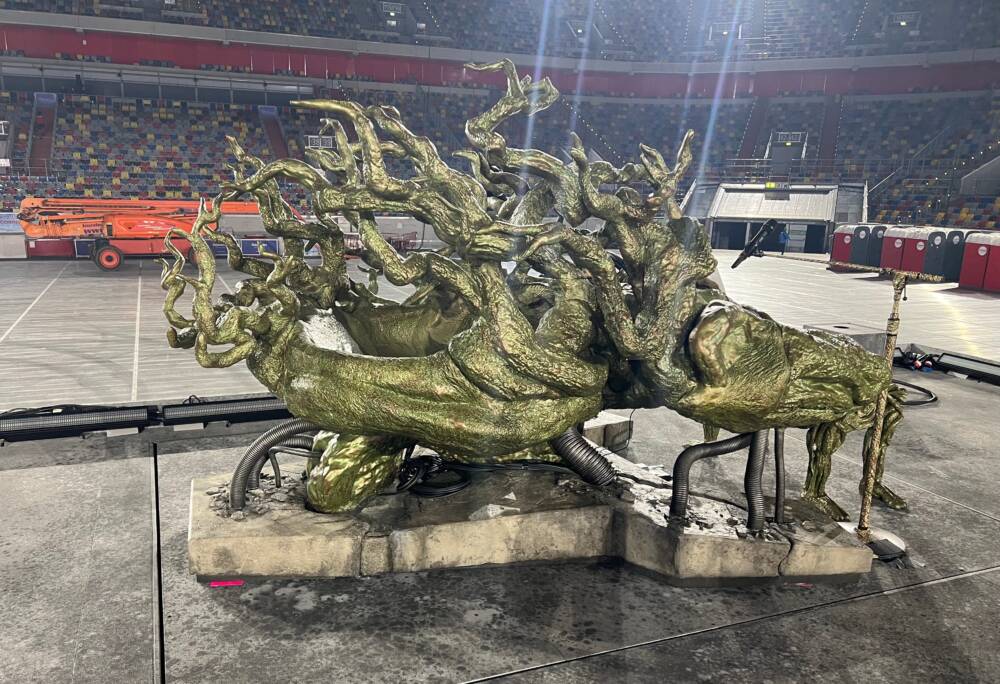Using ZBrush for Lady Gaga’s Chromatica Ball Tour
How renowned artist Deborah Wright created a sculptural extravaganza for the star’s seventh headlining tour.
by Helena Swahn
When large-scale prop company Jet Sets required a ZBrush artist to create a tree-inspired piece for Lady Gaga, traditional and digital sculptor Deborah Wright jumped at the challenge. A set piece of the 2022 Chromatica Ball tour, the complex, twisted fiberglass tree fully encompassed Lady Gaga’s signature piano.
A native of Los Angeles, California, Wright grew up with the magic of Disneyland and Hollywood on her doorstep. Describing herself as a born maker, she trained as an illustrator and traditional sculptor before finding her way to ZBrush. With a 20-year career in themed entertainment, she designs and creates small- and large-scale characters, props and products for film, TV, stage and parade shows, including seven multi-component projects for longstanding client Disney. Among the most notable are the Legend of Mythica at Tokyo DisneySea Japan, The 50th Celebration of Disneyland Mainstreet Parade and Stage show and the Sorcerer’s Apprentice at Disneyland Paris.

We talked with Wright about her unique skillset, how the “Tree of Thorns” piano came to her, what inspired the tortured form and how ZBrush helped her create it. Read on to hear what she had to say, and dive more deeply into her process by joining Maxon for “Demystifying Post-Production: 3D Sculpting for Stage and Screen,” a series of webinars in which Wright shares the entire creative process of taking a client brief for a themed entertainment project from inception to final delivery in ZBrush.
Tune in for each of the weekly webinars on July 10, 17, 24 and 31 at 9 a.m. PDT / 5 p.m. BST / 6 p.m. CEST. Check out the first one here
Describe your path from traditional to digital sculpting.
Wright: I trained as an illustrator and sculptor, jumping into scenic work for TV, movies and Broadway shows. When my son was born, I gave up those crazy hours. I joined a mannequin factory in Hollywood, where I spent almost four years learning traditional sculpting, from design and project management to manufacturing.

When 3D printing began to replace traditional sculpting, I retrained and fell in love with ZBrush. The breadth and depth of what I can do as a digital sculptor is astonishing, but my traditional sculpting skills serve me every single day. Working in entertainment, most of my designs are produced in real life and it helps to understand the physicality of objects and materials.
Can you share a few career-defining projects or people?
Wright: Twenty years ago, I sculpted an 18-inch caterpillar smoking a hookah; it was my first project sent to parade development at Disney Live Entertainment. A year later, I saw my little sculpture, now 18 feet tall, smoking its hookah and moving and rolling its eyes. I loved making maquettes; the challenge of working in scale, knowing that one inch would translate into one foot, really focused me on refining my skills.
I have my great, supportive, inspiring friend Michelle Millay to thank for bringing me in on various life-changing projects and for pushing me to develop my skills and learn ZBrush.
We worked together for many years before I went digital, on gigs like “Planet of the Apes” and again when we were part of the team that helped produce the dragon for Gringotts™ Wizarding Bank at Universal Orlando. She taught me that friendship is a story about support and pushed me to think big.
Can you share a few career-defining projects or people?
Wright: I love it when a client comes to me with an idea that’s not fully fleshed out and wants my contribution. That is a unique experience and what happened on the Gaga show.
My friend Michelle recommended me to Matthew Pomerantz at Jet Sets, who was working on the show. Matthew and I just dovetailed. We both come from a theatrical world and really spoke each other’s language well. We leaned into the brief and had fun making the best we could.

What were you asked to produce and how long did it take?
Wright: They said, “We want a piano in a tree, and we want the tree to look tortured as if it’s suffering.” I also helped to design the piano bench and keytar. The whole project to design the individual pieces ready for production took about six weeks.
What were the challenges of making such a large, complex, physical prop?
Wright: There were some callouts for the tree. They wanted to embed the piano completely, and the whole thing needed to be easily broken apart, transported and reassembled for each show. We also had to accommodate the lift that raised the tree out of the satellite platform on stage. Those real-world problems took a little time to solve.
I worked on it for about three weeks, and there were a lot of changes and wrangling about how we would fit the fabricated fiberglass product to the supporting armature plus the actual piano. Figuring out how to attach the main branches to the armature and easily break the whole thing into parts for shipping to each show was like a 3D puzzle. My practical sculpting experience designing toys and mannequins for disassembly was really helpful. I believe we ended up with five limbs and a trunk that could be packed into cases.

Talk about how you translated suffering and torture into a tree form.
Wright: The brief was wide open for me to design, and I was provided with some mood board imagery and sketches of a skeletal tree. It was very conceptual and brutalist with elements of horror; this tree of thorns was suffering and beleaguered. It was barely alive. I was inspired by a twisted, leaning cypress tree I had seen in Torrey Pines, California. When the first draft of this idea came back with a roaring ‘yes!’ from Lady Gaga herself, we just ran with it.
I researched textures, spending a lot of time running my hands over old trees near my home to get a feel for their branch and bark structure. Then I jumped straight into ZBrush and started modeling this tortured tree, incorporating conduits and wires that emerged from the concrete base with the idea that they had broken through and were feeding it and keeping it alive.
After the tree, it took about a week to design the piano bench. I drew inspiration from the Korova Milk Bar tables in “A Clockwork Orange” and some Aztec sculptures to create the contorted skeleton frame with a horror theme.

Please dig into how you modeled the branch and bark details using ZBrush.
Wright: Addressing each limb and twig individually was a big part of this job. There were no modular elements except for how the branches were attached. Each branch had a unique look, and my brush touched every twig.
I started with a ZBrush plug-in called Ztree by Ignacio Cabrera Peña, which essentially propagates trees, and then used the ZSphere tool to move the limbs, branches, and twigs to get the shapes I wanted.
I always set up the big forms and shapes first, and then I’ll return and do the refinements. I’m a big fan of the Move Topological, Inflate, DamStandard and Chisel brushes. I find that sticking with the basics will take you far.
I used alphas pulled off photos from my research of tree bark to map the rhythm of bark texture on the model. The unification of surface texture came together utilizing Pablander’s Digital Clay pack.

I also made a custom rake to create the tree bark surface texture and grew the tree using a rhythmic massaging technique, raking and moving topology. The challenge was to make each piece as seamless as possible, and knowing it would be manufactured in fiberglass, I used the branch and bark texture to hide seamlines in the material.
Did you get to see your work live on stage?
I saw it in Las Vegas, and the whole presentation with paint, lights, and the atmospheric magic of a live stage show really got me. Everything came together so well, and the bench really worked like I wanted it to—not too obviously human bone but a slow unfolding horror.

It was really special to be entrusted with this project and I’m so proud to have designed and modeled the print files for this vital and complex instrument. Theatrical shows, dramatic set pieces, magnificent pianos and keytars are Lady Gaga’s trademarks and it was spectacular to know I had intuited the design teams’ intention and hit the mark straight out of the shoot.
Do you have any tips for artists who want to get into themed entertainment?
A few of the really important things that have made a difference to me – be generous in your knowledge and fearless in asking questions; to the right people, questions don’t expose your ignorance but your willingness to learn. And be curious and say yes; this has given me more than I ever thought I could have as an artist.
If you could change one thing about the industry, what would it be?
What breaks my heart a little bit is ageism, and I hope that will change. The people I want to work with will consider portfolios primarily by the content and experience demonstrated. Age, race and sex of the artists are inconsequential. Wise art directors remember that artists only get better as they age. This is why it is called an ‘art practice’ as one only becomes a master through perseverance and time.
Finally, are there any new tools you’re learning or want to experiment with?
I’m still infinitely curious and constantly teaching myself new things. Right now, it’s Maxon One. But I think in 3D, and my perfect dream would be to work as a physical sculptor using digital technology. So, fingers crossed that ZBrush will figure out a way to combine haptic gloves and VR. That excites me!
Helena Swahn is a writer in London, UK.
Image Credits: © Maxon, 2023.